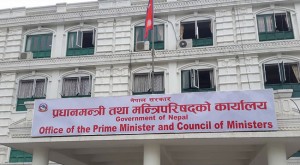
Nepalko Dhan Hariyo Baan, Katne Ropne Magne
Hurkauna Magne Pheri, Jogaune Punha Magne
(Nepal’s green forest is its wealth, cut it down; plant again to raise and beg again to protect)
Chatyaang Master once mentioned how much we love begging. We do love international donations and we love it more when it is for forest conservation. More donations, more commission, more worthless conservation, more villages submerged in bushy forests, more rhinos roaming in the street of Sauraha, more people killed by tigers, more trouble, and more donations.
Nepal has been in the global headlines of success stories for our so-called ‘effective’ conservation endeavour. The collaborative effort of the government, communities, and individuals in the protection and management of natural resources specifically the threatened megafauna is inspiringly admirable.
However, the conservation stories have overshadowed as well as put a ‘protagonist’ tag on the ever-limping timber industry of Nepal. There is barely any established and organised framework, neither on paper nor on the ground, for sustainable timber enterprise because timber harvesting operation is and has always been considered the biggest liability from the perspective of natural resource management.
Therefore, the responsible authority ignores the timber harvesting operation and consequently limits its economic and ecological potential. The legislation of very few timber-friendly policies and their poor execution will nevertheless lead to our increasing reliance on the international market for timber. A reconfiguration of the forest management model and a conscious timber dialogue, thus, need to be on the table if we genuinely believe ‘Hariyo ban Nepal ko Dhan’.
Lack of institutional framework and operational procedure

In 2021, the Ministry of Forest and Environment (MOFE) formulated an extravagant strategic plan to improve Nepal’s forest and environmental sector. It embraced objectives such as increasing forest productivity through sustainable management of forest resources and making Nepal self-reliant on timber and wood products in three years.
However, the accountability of the plan is already questionable because, last year alone, we could not satisfy even a quarter of the market demand through timber supply from our forest. We have forest resources, but we do not have an institutional framework, operational procedure, and infrastructure that could withstand a massive change in the timber situation in Nepal. I have always believed that Nepal could never become a timber-exporting nation, ever.
Contrastingly, the Ministry of Forest and Environment is aiming to make it happen in five years starting from 2021. I find it ridiculously preposterous. Producing quality timbers is a farfetched dream when we are importing even wood charcoal, briquettes, sawdust, wood waste, and scraps.
The vicious chain of idiocracy is transmitted through Ministries. The Ministry of Finance has barefacedly acknowledged the Forest Minisnty’s strategic plan and has formulated the 2022/2023 budget plan for the forest sector accordingly.
The Finance Ministry has expected the forest sector to make a consequential contribution to the GDP and economic growth. It was not an extravagant expectation, and our forest had the potential to boost its contribution to GDP. However, we needed to move from conservative forestry to productive forestry if we wanted to witness the true economic virtue of our forest. It would take time, a lot of time, and effort.
The annual import figure of Rs 7.4 billion was not something the Finance Ministry was looking for. Unfortunately, that was the amount we spent to import wood, articles of wood, and charcoal in 2021/2022.
The Finance Ministry has also allocated Rs 13 billion as a 2022/23 budget for specific economic activities in forest sectors to achieve sustainable development of the forest industry and generate employment opportunities.
In the fiscal year 2021/2022, a similar allocation was made, and the budget implementation operational plan was formulated accordingly. A harvest of more than 25 million cu ft (not even half of the timber demand in the market) of timber was projected for the year 2021/2022.
The Forestry Sector Strategy has set a milestone to supply more than 35 million cu ft of timber annually by 2025/2026. A decent amount of the allocated budget was, as well, disbursed to improve and promote entrepreneurship in the timber industry.
However, as done by most of the government bodies, most of the budget disbursed for the forest was spent on office operation costs. The MOF, infected by common illnesses like research deficiency, ground-reality consideration failure, and irrational budget exploitation-ism, led to poor expense execution.
Subsequently, the timber industry continued to cry out for basic infrastructures such as seasoning plants, effective harvesting tools and machinery, and efficient haulage mechanisms. As a result, just above 14 million cu ft of timber was harvested that year. The preposterous expectation of being self-sufficient in forest products was once again tested and brutally shattered.
Sustainable growth of the timber industry in question

The Finance Ministry and the Forest Ministry continue to aspire to improve the contribution of the forest-based industry to the country’s economy through the implementation of national criteria for sustainable forest management.
Even though the sustainable growth of the timber industry looks achievable on paper, it is and has always been unattainably delusional. The reality is that our timber market cannot sustain itself without imported timber.
There is no product from our timber industry that we are self-reliant on. From logs to finished products, we have imported everything to quench the timber market demand. Therefore, it is rather unsurprising to know that we imported around Rs 1.33 billion worth of veneer sheets, panels, plywood, and paperboard last year.
Most of our harvested timbers are salvaged timbers from dead, dying, and decaying trees. The timber does not possess the quality to compete with its technically engineered imported counterpart. Salvaged timbers are not structurally strong and reliably flexible.
As a result, around Rs 1.2 billion worth of special hardwood and more than Rs 200 million worth of softwood sold in the timber market last year were imported; Rs 1.12 billion worth of wood was from Indonesia alone.
We have imported everything from everywhere. We have paid big bucks for wood pulps, raw materials for papers, wooden furniture, wood chips, densified wood, concrete shutter, and pallets. A good sum of our hard-earned cash has flown into foreign entrepreneurs’ pockets to purchase Non-Timber Forest Products (NTFPs) such as gum and turpentine oils, brooms, brushes, paper wastes, and scraps.
We have bought most of our timber and finished wood products from, guess who, India and China. Besides them, we have also imported from Malaysia, Burma, Indonesia, Thailand, Singapore, Vietnam, Japan, Lithuania, and many other parts of Europe. More dollars are ready to fly abroad, and anticipatedly, we are used to it.
While not a significant purchase in the grand scheme of things, the act of buying foreign wooden handicrafts was personally heart-wrenching for me. The import of French windows and doors, frames for paintings, statuettes, ornaments, and bamboo products are more than just cross-border finance.
It is an example of a saddening reality depicting the dwindling sustainability of our small-scale enterprises of local produces, traditional art, and handicrafts. Handicraft markets, craft galleries, and local shops are not just businesses.
They are an integral part of Nepali identity. Getting them replaced with foreign arts and plastic crafts has raised a serious question. Are we done being ourselves?
We are blessed with 69 different forest types with many different types of trees naturally growing in our soil. They have varying timber, non-timber, ecological, climatic, and cultural values.
They can be served in multiple recipes. Yes, our forest is rich, we ought to stop international begging, at least for our forest.























